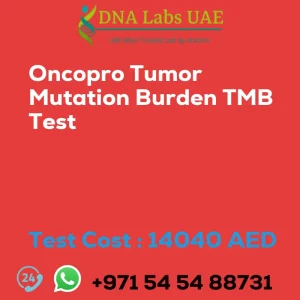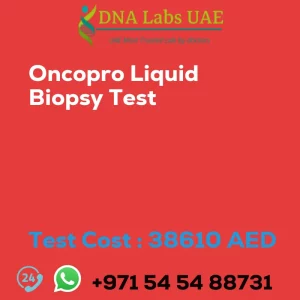IMMUNOHISTOCHEMISTRY HHV-8 Test
At DNA Labs UAE, we offer the IMMUNOHISTOCHEMISTRY HHV-8 test for the detection of Human Herpesvirus 8 (HHV-8) in tissue samples. This diagnostic tool is commonly used in the diagnosis of Kaposi’s sarcoma, a type of cancer that primarily affects the skin and mucous membranes.
Test Components and Price
The IMMUNOHISTOCHEMISTRY HHV-8 test is priced at 610.0 AED. The test components include:
- Sample Condition: Submit tumor tissue in 10% Formal-saline OR Formalin fixed paraffin embedded block. Ship at room temperature. Provide a copy of the Histopathology report, Site of biopsy and Clinical history.
- Report Delivery: Sample Daily by 6 pm; Report Block: 5 days Tissue Biopsy: 5 days Tissue large complex: 7 days
- Method: Immunohistochemistry
- Test Type: Cancer
- Doctor: Oncologist, Pathologist
- Test Department: HISTOLOGY
- Pre Test Information: Provide a copy of the Histopathology report, Site of biopsy and Clinical history.
Test Details
The immunohistochemistry HHV-8 test is performed by staining tissue sections with specific antibodies that target HHV-8 antigens. These antibodies bind to the viral proteins present in the tissue sample, allowing for their visualization under a microscope. The presence of HHV-8 antigens indicates an active infection or viral presence within the tissue.
This test is commonly used in the diagnosis of Kaposi’s sarcoma, as the presence of HHV-8 is a key factor in confirming the disease. It can also be used to differentiate Kaposi’s sarcoma from other similar conditions, such as vascular tumors or inflammatory lesions.
The immunohistochemistry HHV-8 test is typically performed on biopsy samples obtained from the affected area. The tissue is fixed, embedded in paraffin, and cut into thin sections. These sections are then stained with the HHV-8-specific antibodies and examined under a microscope by a pathologist.
The test results are interpreted based on the presence or absence of HHV-8 antigen staining in the tissue. Positive staining indicates the presence of HHV-8 and supports the diagnosis of Kaposi’s sarcoma, while negative staining suggests the absence of HHV-8 or a low viral load.
It is important to note that while the immunohistochemistry HHV-8 test is a valuable tool in the diagnosis of Kaposi’s sarcoma, it is not a standalone test. Clinical history, physical examination, and other laboratory tests may also be used to confirm the diagnosis and guide treatment decisions.
| Test Name | IMMUNOHISTOCHEMISTRY HHV-8 Test |
|---|---|
| Components | |
| Price | 610.0 AED |
| Sample Condition | Submit tumor tissue in 10% Formal-saline OR Formalin fixed paraffin embedded block. Ship at room temperature. Provide a copy of the Histopathology report, Site of biopsy and Clinical history. |
| Report Delivery | Sample Daily by 6 pm; Report Block: 5 days Tissue Biopsy: 5 days Tissue large complex : 7 days |
| Method | Immunohistochemistry |
| Test type | Cancer |
| Doctor | Oncologist, Pathologist |
| Test Department: | HISTOLOGY |
| Pre Test Information | Provide a copy of the Histopathology report, Site of biopsy and Clinical history. |
| Test Details |
The immunohistochemistry HHV-8 test is a diagnostic tool used to detect the presence of Human Herpesvirus 8 (HHV-8) in tissue samples. HHV-8 is a virus that has been associated with the development of Kaposi’s sarcoma, a type of cancer that primarily affects the skin and mucous membranes. The immunohistochemistry test involves staining tissue sections with specific antibodies that target HHV-8 antigens. These antibodies bind to the viral proteins present in the tissue sample, allowing for their visualization under a microscope. The presence of HHV-8 antigens indicates an active infection or viral presence within the tissue. This test is commonly used in the diagnosis of Kaposi’s sarcoma, as the presence of HHV-8 is a key factor in confirming the disease. It can also be used to differentiate Kaposi’s sarcoma from other similar conditions, such as vascular tumors or inflammatory lesions. The immunohistochemistry HHV-8 test is typically performed on biopsy samples obtained from the affected area. The tissue is fixed, embedded in paraffin, and cut into thin sections. These sections are then stained with the HHV-8-specific antibodies and examined under a microscope by a pathologist. The test results are interpreted based on the presence or absence of HHV-8 antigen staining in the tissue. Positive staining indicates the presence of HHV-8 and supports the diagnosis of Kaposi’s sarcoma, while negative staining suggests the absence of HHV-8 or a low viral load. It is important to note that while the immunohistochemistry HHV-8 test is a valuable tool in the diagnosis of Kaposi’s sarcoma, it is not a standalone test. Clinical history, physical examination, and other laboratory tests may also be used to confirm the diagnosis and guide treatment decisions. |







